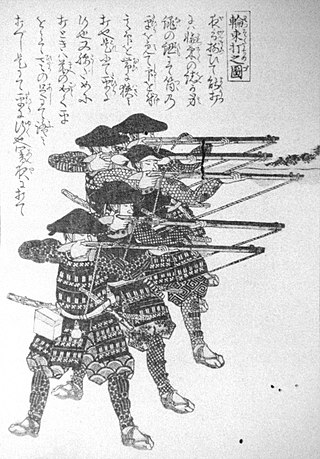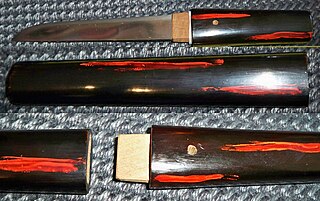
Samurai were the hereditary military nobility and officer caste of medieval and early-modern Japan from the late 12th century until their abolition in the late 1870s during the Meiji era. They were the well-paid retainers of the daimyo, the great feudal landholders. They had high prestige and special privileges.

The daishō—"large and small"—is a Japanese term for a matched pair of traditionally made Japanese swords (nihonto) worn by the samurai class in feudal Japan.

A cuirass is a piece of armour that covers the torso, formed of one or more pieces of metal or other rigid material. The word probably originates from the original material, leather, from the French cuirace and Latin word coriacea. The use of the term "cuirass" generally refers to both the breastplate and the backplate pieces; whereas a breastplate only protects the front, a cuirass protects both the front and the back of the wearer.

A tantō is one of the traditionally made Japanese swords that were worn by the samurai class of feudal Japan. The tantō dates to the Heian period, when it was mainly used as a weapon but evolved in design over the years to become more ornate. Tantō were used in traditional martial arts. The term has seen a resurgence in the West since the 1980s as a point style of modern tactical knives, designed for piercing or stabbing.

Ashigaru were infantry employed by the samurai class of feudal Japan. The first known reference to ashigaru was in the 14th century, but it was during the Ashikaga shogunate that the use of ashigaru became prevalent by various warring factions.

Plate armour is a historical type of personal body armour made from bronze, iron, or steel plates, culminating in the iconic suit of armour entirely encasing the wearer. Full plate steel armour developed in Europe during the Late Middle Ages, especially in the context of the Hundred Years' War, from the coat of plates worn over mail suits during the 14th century.

Lamellar armour is a type of body armour, made from small rectangular plates of iron or steel, leather (rawhide), bone, or bronze laced into horizontal rows. Lamellar armour was used over a wide range of time periods in Central Asia, Eastern Asia, Western Asia, and Eastern Europe. The earliest evidence for lamellar armour comes from sculpted artwork of the Neo-Assyrian Empire in the Near East.

Kabuto is a type of helmet first used by ancient Japanese warriors that, in later periods, became an important part of the traditional Japanese armour worn by the samurai class and their retainers in feudal Japan.

Scale armour is an early form of armour consisting of many individual small armour scales (plates) of various shapes attached to each other and to a backing of cloth or leather in overlapping rows. Scale armour was worn by warriors of many different cultures as well as their horses. The material used to make the scales varied and included bronze, iron, steel, rawhide, leather, cuir bouilli, seeds, horn, or pangolin scales. The variations are primarily the result of material availability.

The ō-yoroi (大鎧) is a prominent example of early Japanese armor worn by the samurai class of feudal Japan. The term ō-yoroi means "great armor."

Men-yoroi (面鎧), also called menpō (面頬) or mengu (面具), are various types of facial armour that were worn by the samurai class and their retainers in feudal Japan. These include the sōmen, menpō, hanbō or hanpō, and happuri.

Sangu is the term for the three armour components that protected the extremities of the samurai class of feudal Japan.

Haramaki is a type of chest armour (dō) worn by the samurai class of feudal Japan and their retainers.

Munition armour was mass-produced armour stockpiled in armouries to equip both foot soldiers and mounted cuirassiers.

A kaiken is a 20–25 cm (7.9–9.8 in) long, single or double-edged Japanese knife usually without ornamental fittings housed in a plain but lacquered mount.

The guntō was a ceremonial sword produced for the Imperial Japanese army and navy after the introduction of conscription in 1872.

Scholars agree that Japanese armour first appeared in the 4th century, with the discovery of the cuirass and basic helmets in graves. During the Heian period (794-1185), the unique Japanese samurai armour ō-yoroi and dō-maru appeared. The Japanese cuirass evolved into the more familiar style of body armour worn by the samurai known as the dou or dō, with the use of leather straps (nerigawa), and lacquer for weatherproofing. Leather and/or iron scales were also used to construct samurai armours, with leather and eventually silk lace used to connect the individual scales (kozane) of these cuirasses.

Tatami (畳具足), or tatami gusoku, was a type of lightweight portable folding Japanese armour worn during the feudal era of Japan by the samurai class and their foot soldiers (ashigaru). The Tatami dō or the tatami katabira were the main components of a full suit of tatami armour.

Dō or dou (胴) "breastplate, cuirass" is one of the major components of Japanese armour worn by the samurai and ashigaru or foot soldiers of feudal Japan.

Karuta was a type of armour worn by samurai warriors and their retainers during the feudal era of Japan. The word karuta comes from the Portuguese word meaning "card" (carta), as the small square or rectangular plates that compose the armour resemble traditional Japanese playing cards.




















